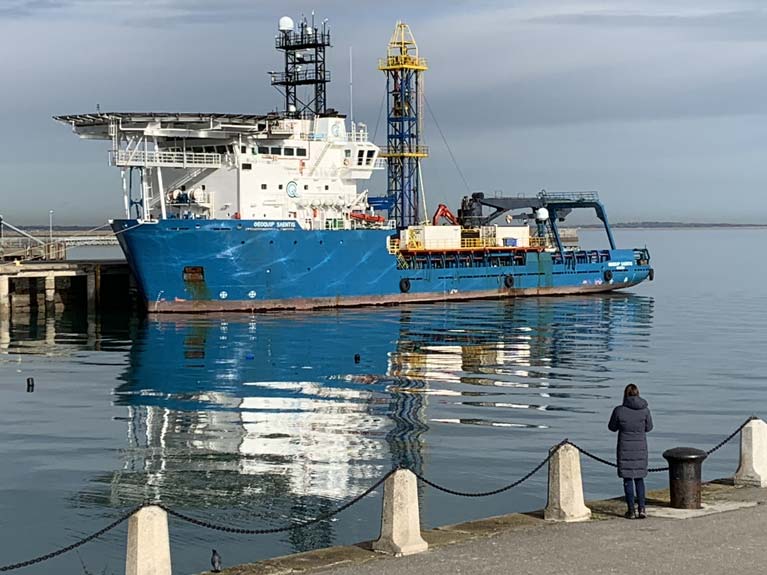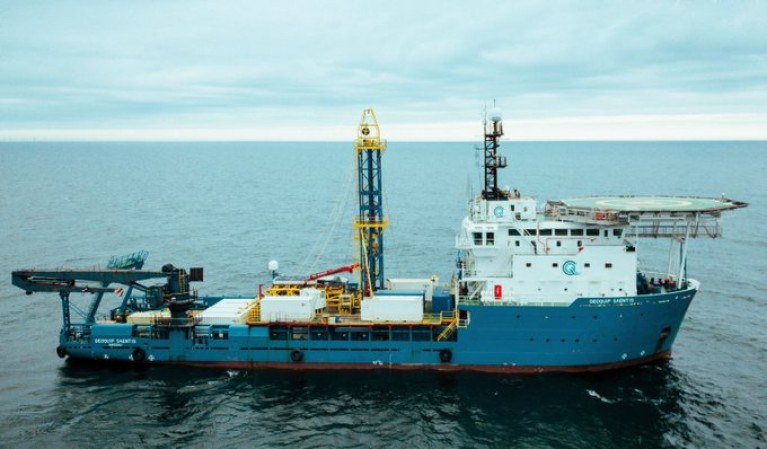Displaying items by tag: Oil to Wind
Drilling-Rig Ship Operated by Landlocked Shipping Company Calls to Dun Laoghaire Harbour
A drilling-rig ship operated by a Swiss-based offshore geo technical data solutions company is currently berthed in Dun Laoghaire Harbour, writes Jehan Ashmore.
According to Dun Laoghaire-Rathdown County Council, the drilling-rig ship Geoquip Saentis is in the harbour to mobilise for work on the Oriel Wind Farm project to the east of Dundalk Bay. The vessel is expected remain in port until tomorrow or Friday.
The 3,404 gross tonnage drill-ship run by Geoquip Marine Operations AG based in St. Gallen, in north-east Switzerland near Liechtenstein, specialises in diverse market segments among them Offshore Renewables, Oil & Gas and Mineral Extraction.
The Swiss shipping firm has a fleet of offshore geotechnical drilling rigs. As for Geoquip Saentis, this drilling rig ship has a Dynamic Positioning (DP2) system for navigational on-site high precision accuracy. In addition, the Multi-Purpose Offshore Support vessel has an on board soil laboratory where data is analysed for clients of projects that can be nearshore (as in project in Dundalk Bay) to waters of ultra-deep oceans.
Afloat tracked the Geoquip Saentic which sailed from Nigg on the Gromarty Forth in north-east Scotland. Also offshore of Aberdeen, the ship in October completed its first geotechnical site investigation in the North Sea involving drilling to over 2000 metres.
The arrival of Geoquip Saentis to the Irish Sea involved a transit through the North Channel. After anchoring in Dublin Bay yesterday, a pilot was transferred on board from Dublin Port Company's new cutter DPC Tolka as previously reported.
 Geoquip Saentis along side in Dun Laoghaire Photo: Afloat
Geoquip Saentis along side in Dun Laoghaire Photo: Afloat
In observing the design of Geoquip Saentis, Afloat concluded the vessel was a former platform supply vessel (PSV) which has been identified as the former Toisa Viligant. The vessel built in 2005 was specially designed to supply offshore oil and gas platforms. Following the acquisition by Geoquip Marine which coincidentally took place on this date exactly a year ago, the ship received conversion overhaul works to enable offshore geotechnical operations.
The major overhaul of Geoquip Saentis took place in the UK at Cammell Laird, the shipyard on Merseyside (see yesterday's Afloat coverage) of the Royal Fleet Auxiliary's tanker RFA Fort Victoria.
The drilling ship was dry-docked at the facility in Birkenhead on the Wirral Peninsula, which included notably the installation of Geoquip’s GMR600 marine drill-rig situated amidships as demonstrated in the above photo. Underneath the rig is a 4m x 4m moon pool.
Geoquip Saentis has accommodation and workspaces for 55 crew members. At 80m in length and an 18m beam, this provides a stable platform for offshore geotechnical operations which includes use of a Remotely Operated Vessel (ROV) to operate alongside the drill-rig.





























































